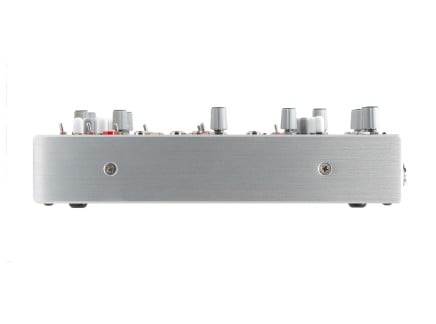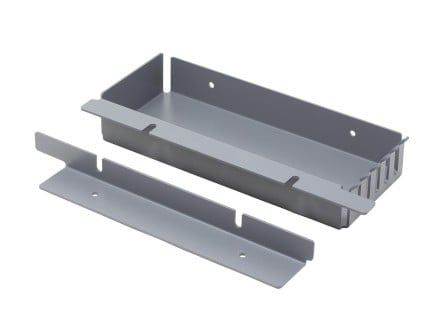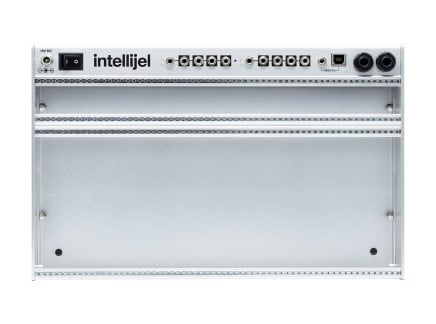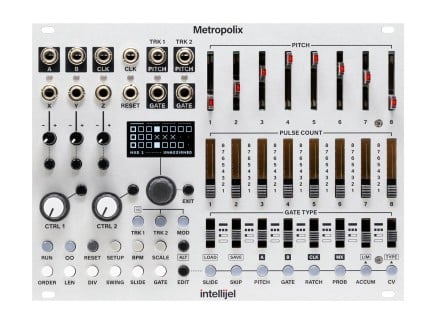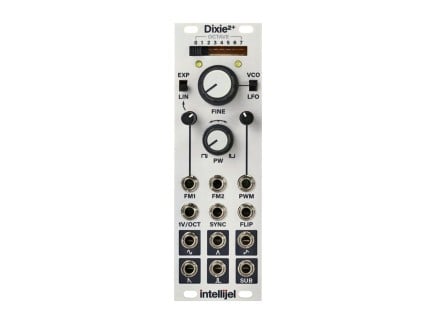Following years of rumors and a single tease on social media in September 2022, Intellijel's Cascadia is finally here. Thankfully, it's not the gigantic 64hp buffered multiple shown on April Fool's Day, but a full-fledged, premium semi-modular synthesizer.
As Intellijel's first standalone product, Cascadia features a rich blend of analog and digital synthesis elements. It's a deep and powerful semi-modular synthesizer pulling in aspects of new and old Intellijel designs, mixing them with influences from classic synthesizers, and dressing it all up in Intellijel's signature design language. Cascadia is perfectly suited for anyone who wants or needs an instrument with zero compromises—even without using a single patch cable, this is a thorough and flexible machine that goes well beyond what a typical monosynth would offer.
We've been looking forward to Intellijel's entry into the semi-modular world, and while we certainly expected it to be packed to the brim with features, we're delightfully taken aback at how much Cascadia has to offer. Honestly, we find something new every time we look at it!
This article is an extended overview of Cascadia's capabilities as a sound source, performance instrument, and powerful companion to any piece of gear: modular, effects pedals, and more. As a special bonus, Intellijel founder and lead designer Danjel van Tijn graciously took some time to do an interview with us! Offering some key insight into how Cascadia came to be, elaborating on certain design choices, and even sharing some fun and interesting patching tips, making it a must-read for anyone interested in Cascadia.
An Overview of Intellijel's Cascadia
At first glance, astute observers that have been following Intellijel for a while might notice some similarities between Cascadia and Atlantis, which is itself inspired by Roland's SH-101. And while that beloved full-voice module might have provided some initial design inspiration, Cascadia quickly took on a life of its own as development progressed. Considering that Intellijel has also produced a number of powerful digital modules in the realm of modulation and control voltage generation since the release of Atlantis, it's hard to imagine that those didn't play a role in Cascadia's design.
As a semi-modular instrument, Cascadia features just about every standard synthesis block you could ever want or need in a single, monophonic box. We'll cover these in more detail below, but flexible oscillators, filters, VCAs, and numerous utilities and control voltage generators ensure that there are always interesting patches to be found. Intellijel even included a full MIDI-CV converter with a number of assignable and configurable outputs to allow Cascadia to more easily fit in with your favorite controllers, hardware sequencers, and DAW templates.
There are a staggering number of thoughtful signal paths built into Cascadia, such that you can easily make plenty of interesting sounds without patching! But as with any other semi-modular synth, you can re-route audio and control signals at will with some patch cables. With over 100 patch points, Cascadia is on par with even some more sophisticated full-modular systems out there. But don't be intimidated by this—if you make a connection that doesn't sound or work as expected, removing the patch cable will revert to the default normalization.
However, to me, Cascadia exemplifies one of the strongest advantages to semi-modular synthesizer designs: the opportunities for stronger control integrations between "modules" are plentiful. Many of these normalizations even rival those that would be found on traditional keyboard synthesizers. Connecting an external MIDI controller to Cascadia provides instant control over oscillator pitches, filter cutoff, and envelope triggering from note data alone, while MIDI clock automatically triggers the sample and hold for random voltage generation. All of this and more lead to a crucial point—you'll spend much less time patching Cascadia and more time making music with it.
Visually, Cascadia is a slick grey machine adorned with numerous sliders, knobs, and patch points. As such, there's a lot of to read across the panel, but when it comes to labeling their synthesizers Intellijel has one of the most clear design languages out there. When in doubt, remember that jacks with white blocks around them are outputs and unenclosed jacks are inputs. Arrows and lines denote signal flow or relationships between parameters, patch points, and other aspects of the instrument. Even the slider cap color has significance: lighter caps represent initial values before modulation, while darker sets the level of modulation.
Cascadia's Audio Signal Path
One of the most important aspects of a synthesizer is its audio path, and, in true Intellijel fashion, Cascadia has no shortage of timbral options at its disposal. You'll find a blend of East Coast and West Coast synthesis elements brought together in a modern package, with features now considered standard on contemporary Eurorack modules.

Sounds begin with Cascadia's VCOs—two true analog oscillators offering different feature sets for versatility in a variety of patches. VCO A is simply stacked, supporting over eight octaves of tuning range, sub-oscillators, through-zero FM capabilities, selectable hard or soft sync, and more. VCO B on the other hand is more utilitarian in its features, able to function as both an audio-rate or low frequency oscillator. Its tracking and response is still rock-solid though, and it can even be decoupled from its shared pitch input with VCO A.
VCO A's outputs, along with up to two other input sources and a noise generator, are summed in a primary mixer at the top of Cascadia, before running into the filter. And boy, is Cascadia's filter an attraction. Dedicated four-pole lowpass and highpass outputs keep these dependable filter types available at any moment, while the main output may select one of eight different modes for a variety of timbres. These include lowpass filters with one, two, or four poles, bandpass at two or four poles, highpass at four poles, as well as a notch and phaser mode—more poles means that the filter exhibits a stronger frequency roll-off. There's also plenty of resonance for juicy filter sweeps and special effects with the phaser mode.

After the filter, most monosynths round out their signal path with a VCA for amplitude control before heading onto the main outputs. While VCA does serve this purpose, Cascadia once again goes above and beyond the norm by incorporating desirable elements from other types of synthesizers. Notably, the inclusion of a Buchla-style wavefolder after the filter means you coax even more harmonics and timbres out of Cascadia than an SH-101-style synth would normally ever dream of generating. There's also a Ring Modulator in the Utilities section (more on this later), and a secondary lowpass filter with its own VCA (VCA B) for lowpass gate-type sounds and patches.
Along the very top of Cascadia's front panel are some patch points for external connections, along with a few other niceties. Notably, Intellijel has included not only a Line Input for external instruments, but also an integrated Effects Loop. As Cascadia does not feature it's own internal effects, you can easily incorporate your favorite pedals and effects into your patches for additional space, dimension, or decimation. One of the most interesting inclusions here is an expression CV output, featuring a digitally-controlled potentiometer that emulates an actual expression pedal, allowing you to modulate your favorite pedals with any signal imaginable.
The main audio output path also features a global overdrive with optional soft clipping, so you can make Cascadia sound as smooth or crispy as you'd like. You'll find essential I/O on the back panel: 1/4" jacks for audio input, output, headphones, and the effects loop, along with 5-pin MIDI in, out, and thru plus USB-C MIDI.
Modulation + More: Cascadia's CV Generators and Utilities
Audio signals are only one part of any synthesizer's story, and Cascadia has much more to say with its control voltage capabilities. Intellijel has brought out an array of digital CV generators and modulators over the last several years, and Cascadia ventures even further down this path. But these are supplemented with a number of analog utilities, affording a variety of patching opportunities that will never leave you bored.
Cascadia's super-charged envelopes are one of the few digital elements you'll find among its mostly analog circuitry. Digital implementation offers the key advantage of making features that would otherwise be impossible in the analog realm to be available on Cascadia, and this means that your patches will be much more interesting. And don't worry—Intellijel chose super fast, high-quality DACs for envelopes as snappy and responsive as you'll ever need.

Envelope A is an ADSR-style envelope with a few key additions for potentially advanced CV generation. Notably, a Hold stage is available to extend the envelope in a couple of different ways: either as an extension of the Attack stage's peak voltage, or a secondary gate generator to create full envelopes out of triggers or gates of varying lengths. This envelope can also modulated by MIDI velocity or an external CV signal to change its time or maximum amplitude, and End of Hold and End of Attack stage outputs allow for cascaded triggering of other elements on Cascadia.
On the other hand, Envelope B is a malleable function generator that can operate in a myriad of ways. There are so many options here—envelope is just one suggestion, as LFOs and Burst generation are also easily possible, and tempo or clock synchronization is available with the Sync input. In any mode, Rise and Fall controls set the times that it takes for voltages to ramp up or down, and when synced the Rise control allows for clock division or multiplication. Another interesting feature is the Low Frequency Vacillator mode, a sort of chaotic oscillator with random deviations.

Cutting right through the middle of Cascadia is a row of utility blocks, allowing for the convergence of audio and control signals to weave a web of complex interactions and relationships. We've already mentioned the Ring Mod and VCA B / LPF blocks, but there's plenty more to talk about here. At the left is an essential Sample and Hold, defaulting to input from MIDI Clock and White Noise for synced random voltage generation. Smooth out the S&H (or any other signal) with the adjacent Slew Limiter and Envelope Follower, able to create ramps in positive and negative directions, or both. There's also a triple LFO with three outputs labeled X, Y, and Z, with a shared Rate control and division switches for the Y and Z outputs.

The rest of the Utility row is filled with essential bread-and-butter patching blocks that real modular heads will be excited about. This is the place to condition Cascadia's signals for more customized modulations of other signals. In the multi-functional Mixuverter, signals may be summed, inverted, scaled, biased, and multed for distributed patching across Cascadia. There are also chainable buffered multiples, a secondary summing block, a signal inverter, and a bipolar to unipolar converter. Finally, the EXP SRC allows you to pass in any signal as a modulator for the effects loop's Expression output.
If it's not clear by now, Cascadia can do a lot—and the many switches and buttons found across its functional blocks provide a wide range of conifgurations. In fact, Cascadia is so configurable that Intellijel developed a companion software application for tailoring deeper settings to your needs. Indeed, the Intellijel Config App gives you more control over various aspects of Cascadia's MIDI capabilities as well as tweak some choice synthesis parameters. These range from everything like MIDI Channel and Note Prority settings to MIDI Clock Divisions, Envelope Burst shapes, Alt Noise types, and more.
Behind the Scenes + Designer Insights: Interview with Danjel van Tijn

Perfect Circuit: Intellijel has exclusively made Eurorack modules and cases for years now, what prompted the development of a standalone instrument?
Danjel van Tijn: Well before Intellijel ever existed, I had always dreamt about developing standalone musical devices. Once Intellijel came to fruition and started to create Eurorack modules, I finally felt like there was a viable path to achieve this goal. Each module we developed could become a building block towards an eventual bigger device. Atlantis was kind of an important milestone because it was the first proper integration of several other smaller predecessor modules into an entire synth voice. The next logical step was to turn this into a small, desktop device but there are a lot of other developments and shifts in focus that have happened since that initial release.
PC: We've heard rumors and teases of a semi-modular device from Intellijel for awhile now. How long have you been working on Cascadia? Can you talk about your design process? What challenges came up along the way?
DT: Looking through our design folder, I found preliminary concept sketches for Cascadia dating back as far as 2018! With this type of project, we knew that we pretty much had all the underlying circuit blocks we needed (VCOs, Filters, Envelopes, Amps, Midi, etc.) but it would be a major exercise in user interface design and feature constraint to turn this into an original instrument that met our design goals.
We generated countless iterations of panel concepts and hotly debated every feature and design choice. Due to the size and complexity of this project (especially the actual PCB), we knew that we would not have the luxury to build a lot of physical iterations. This meant we really had to work with the concept sketches, mockups, and our imagination as much as possible before committing to a full PCB prototype layout and build. I still have some of the 3D cardboard mockups I made from the early development periods.
Adapting to the longer time-frame, especially with some unprecedented delays stemming from the pandemic, was one of the most challenging aspects of this entire development process.
PC: We can trace some of the design choices of Cascadia back to Intellijel's full synth voice module Atlantis, but there is so much more going on here. What were some key things that you wanted to change from Atlantis? And where else did you look for inspiration?
DT: Atlantis was a very loose starting point because we knew that architecture worked well for classic subtractive synthesis and we loved the sound and versatility of that filter topology. However, we understood that the design had to become far more modular and incorporate a lot of key “west coast” synthesis elements from instruments like the Buchla Easel. This meant adding wavefolding, extensive FM and AM, random sources, and a powerful voltage-controlled function generator.
There is also a small nod to the Arp 2600 with how we chose to label all the jack normals, which just makes it so easy to navigate. We also tried to incorporate some of the robust industrial design and clear layout of the Cwejman S1 mkii (even using the same high-quality sealed switches).
Although we have taken some inspiration from a few classic semi-modular synths of the past, Cascadia is a totally modern design. Intellijel has spent the past 15 years developing and refining our own proprietary circuits and code, and all of these original ingredients have gone into making Cascadia something that is uniquely our own.
PC: Why is it called Cascadia? Any influence from your geographical surroundings?
DT: ‘Cascadia’ is the name of a theoretical bioregion that spans the West coast of Canada and the USA. Since Intellijel is based in Vancouver, Canada we are essentially right in the middle of Cascadia so it seemed fitting to pay tribute.
PC: Semi-modular synthesizers have a reputation as being suited for modular synthesis newcomers, both in terms of functionality and affordable entry. However, Cascadia feels more like a premium instrument with zero compromises. How did you arrive at this design?
DT: We like to think of this as a “Synthesist's Synthesizer”. If you invest the time to learn this instrument, you will be rewarded with so many options and ways of doing things. We have provided the controls and functional elements to really dial in and fine tune your sounds.
For a newcomer, a semi-modular synth might be less daunting to work with than a full modular system. It has been designed to facilitate quick results via the normals and switches. Also we have made sure to have attenuators or attenuverters on almost every single possible control input; this alone is something missing from so many designs but greatly enables one's ability to configure their patch and sound.
It was also really important that we used high quality, long-life components on the inside and outside. This added significantly to the build-cost, but it ultimately makes Cascadia a far more durable and reliable instrument as a result.
The design was really born out of our collective experience of patching and tweaking modular synths for so many years. We knew what core modules and patch connections we always seemed to want or need and with Cascadia we have finally been able to integrate these into a cohesive system.

PC: Which aspects of Cascadia are analog, and how much of it is digital? How did you delegate certain functions to circuitry or code? Did any recent Intellijel modules influence your decisions?
DT: Almost every functional block on Cascadia is analog, including the entire audio path. The only digital elements are the MIDI to CV, the synthesized noise, and the envelopes. We chose to make the envelopes digital because we wanted to implement complex behavior that would have been almost impossible to do in the analog domain. We use high resolution DACs and a fast processor so these can be as quick and snappy as analog envelopes. In fact, We did extensive comparison and measurements against our own analog envelope designs to make sure of this.
The ADSR / AHDSR is a new design that does not exist in any of our modules currently. The HOLD can serve several purposes such as adding an extra stage in the envelope shape e.g. AHDSR, but is also really useful for allowing a short trigger from a sequencer to generate a longer ADSR shape. This latter functionality is somewhat similar to the trapezoid generator on an EMS Synthi and is great for generative drones. We also added a special control input (CTRL) that can serve two different functions: dynamic control of the envelope level, or dynamic control of the envelope time. This input pairs really well with MIDI Velocity to really add some dynamics to your patch.
The Envelope B section is even more versatile. We call it an “envelope” but really it is a complex function generator with three distinct modes: Envelope, LFO and Burst generator. Each of these primary modes has three additional states. So, for example, the envelope can be triggered, held, or cycling; while the LFO can be free, beat synced or LFV (Low Frequency Vacillator; a special random mode); and the burst generator can be triggered, gated and looping. The looping burst generator is especially fun to experiment with.

PC: A number of us here at Perfect Circuit are guitarists or effect pedal aficionados, so we're excited to see an external effects loop on Cascadia! The expression output is especially cool—how did that inclusion come about? Are there any specific Cascadia + pedal combos that you and the Intellijel crew have been enjoying?
DT: There are so many incredible guitar pedals, many of which are dirt cheap and sound great on synths. Instead of integrating a basic effect block into Cascadia, we thought it would be more powerful to add an effect send/return loop that you could properly interface with guitar pedals (and line level devices too). This just opens up so many creative possibilities and a fun way to spice up your sound with external fx chains.
You could obviously just take the final output of Cascadia and run that directly into an effect processor and this would be the typical way to add some reverb/delays at the end of the chain (which sounds great!). However, the send/return loop can offer far more routing flexibility since you can insert the effect somewhere else in the Cascadia signal path such as pre-VCA or pre-VCF. A good application for this is if you had a really high-gain and noisy distortion pedal, you could patch that pre VCA input. Now whenever the VCA is closed, so is the noise from the pedal and you effectively have a noise gate.
As for favourite pedals, there are so many to choose from! What may sound good on guitar does not necessarily sound good on a synth and vice-versa. I also really like to chain together several pedals to make a more complex chain.
We have also included another unique feature which is our expression pedal output system. This is actually a digitally controlled analog potentiometer (digipot) connected to the internal CPU. When you patch CV into this (via the EXPR SRC section), that signal gets translated into varying resistance on the digipot to mimic the way a physical, analog expression pedal works. This allows you to patch into the expression input of pedals to get CV control of pedal parameters from Cascadia modulators.

PC: One way that an end-user can customize their Cascadia is with the Intellijel Config App. What prompted your team to develop this as a way to get more out of Cascadia?
DT: A few of our recent module designs have started to incorporate a configuration utility that allows users to make some very specific functional changes to their device. We try to reserve these to the “set and forget” type parameters and almost never the important things you would want to change via the front panel controls. Since the Cascadia is a big system with an extensive MIDI to CV interface, we knew it would be a good idea to incorporate this configuration utility to maximize compatibility and adaptability to specific uses. There are also some behavioral options for some of the other sections, like selecting if the envelope section logic outputs (EOH, EOA, EOC) are short triggers or long gates. If you have a Cascadia, it is definitely worth exploring this for a few minutes and then making some customisations based on your own needs.
PC: Tell us all about that 19" rackmount adapter! Is that cable hanger built into it? Where did that idea come from?
DT: Since Cascadia is not a full 19” rack width, we thought it would be more interesting to create a little storage area at the side instead of just an extra wide rack ear. We thought you could use this section to put a little guitar pedal, recorder, small sequencer or just a bunch of cables. The tines at the top can be used for hanging patch cables and they are spaced wide enough so that you route thicker audio cables through them to the back of the Cascadia or somewhere else.
PC: Finally, when can we expect to see Cascadia start shipping out into the world?
DT: It is ready today (April 14th 2023) and will begin shipping to dealers next week. We are beyond excited to hear the music and wild sounds that people will make with Cascadia!
Cascading Sound Waves
Intellijel's foray into standalone instruments has been a long time coming, and the Perfect Circuit staff felt much excitement upon seeing Cascadia for the first time. And we think that a lot of folks will feel the same way that we do, especially once they hear it and use it for themselves.
Of course, we love sprawling modular systems as much as we love the more focused semi-modular synthesizers out there. But Cascadia fits into a unique position between both of these formats, finding the perfect balance of a feature set that feels both curated and holistic. Most importantly, as Cascadia drew from both Intellijel's own catalog and iconic synthesizers for its design, we hope that Cascadia inspires other modular makers to explore more adventurous instrument ideas in standalone formats.










